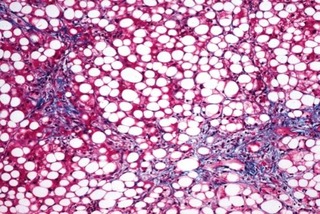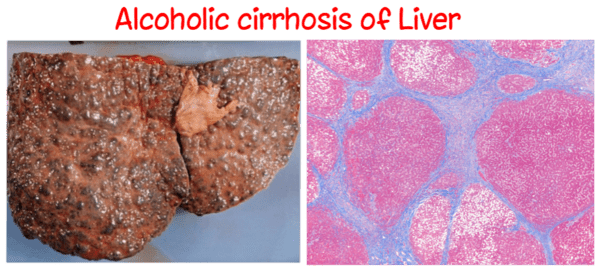Pathology of Hepatitis: Acute, Autoimmune, Chronic and Liver Cirrhosis
Feb 15, 2023
Navigate Quickly
Acute Hepatitis
Apoptotic Body
Chronic Hepatitis
Portal Tract Expansion
AUTOIMMUNE HEPATITIS
Hepatocyte Rosette formation
Interface Hepatitis
Types of Autoimmune hepatitis
LIVER CIRRHOSIS
Etiology
Findings of Alcoholic Steatohepatitis
Alcoholic Liver Cirrhosis (Laennec's Cirrhosis)

Acute hepatitis is an important topic for the NEET PG exam because it is a common and potentially serious condition that affects the liver. It can present with symptoms that overlap with other conditions, and thus, a clear understanding of this topic is crucial for medical students.
In this blog, we cover the pathology of Hepatitis topic including acute, chronic and liver cirrhosis for NEET PG Preparation.

Acute Hepatitis
The above image shows swollen up hepatocytes which suggests acute hepatitis. Swollen up hepatocytes are termed as Ballooning Degeneration of hepatocytes.
- In ballooning degeneration: cell size is swollen up.
- Nucleus is the central and Cob-web cytoplasm.
- To diagnose acute hepatitis in a patient suffering from hepatitis B infection
- HBsAg +
- Marker of high infectivity is HBeAg.
- Hepatitis A,E causes acute hepatitis.
Apoptotic Body
- Presence of dense eosinophilic structure is called “Apoptotic Bodies”. There is Apoptosis of affected Hepatocytes that responsible for loss of nuclear material
Important Information
- Apoptotic Body associated with viral hepatitis Known as “Councilman Body”
Also Read: Thalassemia - Symptoms and Causes - NEET PG Pathology
CHRONIC INFLAMMATION: Symptoms, Causes, Diagnosis, and Treatment: Pathology
Amyloidosis: Types, Causes, Symptoms, Diagnosis, Risk Factors, Treatment

Chronic Hepatitis
Chronic hepatitis is caused by hepatitis virus B, C, D. Hepatitis D virus cannot cause infection alone, it is dependent on hepatitis B virus. The image shows Ground Glass Hepatocytes. HBsAg is responsible for Ground Glass appearance. HBsAg is present inside the cell due to which the cell has hazy cytoplasm (“Dull Cytoplasm”). These cells are also called as “Hadziyannis Cells”
Portal Tract Expansion
- It is due to infection caused by Hep. C. There is infiltration caused by mononuclear cells and these cells are going to cause infiltration around Portal Tract: Responsible for portal Tract expansion
AUTOIMMUNE HEPATITIS
- Hepatocytes have a multinucleated appearance. In this Emperipolesis is present which is a Cell within a cell phenomenon; it indicates that a Big cell is eating up a smaller cell, but both these cells remain viable.
Hepatocyte Rosette formation
- Hepatocytes arrange themselves in flower like fashion which is known as hepatic rosette formation.
Interface Hepatitis
Interface hepatitis, also known as piecemeal necrosis, is an inflammatory and erosive condition that affects the hepatic parenchyma at the point where it meets portal tracts or fibrous septa.
The name "interface hepatitis" was created because the death of hepatocytes occurs at the parenchymal-connective tissue interface and is likely to include apoptosis rather than, or in addition to, necrosis.
- Portal Tract is having infiltration caused by plasma cells as well as lymphocytes
Important Information
- Presence of Interface Hepatitis and Hepatic rosette is associated with Autoimmune Hepatitis
Types of Autoimmune hepatitis
- Type 1 Autoimmune Hepatitis has presence of ‘ANA’(Antinuclear Antibody) and sometimes “ASMA Positivity” (Anti Smooth Muscle Antibody)
- Type 2 Autoimmune Hepatitis has “Anti LKM1 Antibody” (Anti Liver Kidney Microsome Antibody)
- Type 3 Autoimmune Hepatitis → ANA negative, SLA positive (Soluble liver Antigen)
LIVER CIRRHOSIS
- When healthy liver tissue is replaced with scar tissue, a late-stage liver disorder known as cirrhosis results in the liver suffering irreparable damage. Scar tissue prevents your liver from functioning properly. Multiple liver conditions and diseases damage healthy liver cells, causing cell death and inflammation. Following cell repair, tissue scarring is the result of the repair process. The liver's capacity to create proteins and other substances is also decreased. Cirrhosis eventually inhibits the liver from operating correctly. late-stage, life-threatening cirrhosis
| Micronodular Liver Cirrhosis | Macro Nodular Liver Cirrhosis |
| Nodule size <3 mm Associated with metabolic disorders. | Nodule size > 3 mm E.g., Iron metabolism, copper metabolism, 1-Antitrypsin deficiency, Wilson's disease |
Etiology
- Chronic Alcohol Intake
- Fatty Change of Liver (Mild Intake of Alcohol)
- Alcoholic Steatohepatitis (Moderate Intake of Alcohol)
Findings of Alcoholic Steatohepatitis

- Presence of Intermediate filaments – made up of Cytokeratin 8 and 18 known as “Mallory Denk Body”
- Mallory Denk Bodies are nonspecific findings.
- It is seen in
- Alcoholic hepatitis
- 1 antitrypsin
- Tumors like hepatocellular carcinoma.
- Chronic cholestasis
- Wilson's disease.
- “Chicken - Wire Fence” Pattern

- Perisinusoidal Fibrosis- deposition of collagen in a pattern giving chicken – wire fence appearance. Stain used for collagen is Mason's Stain (To detect the perisinusoidal Fibrosis and Collagenous deposition).
Also Read: Inflammation Types - NEET PG Pathology
SICKLE CELL ANEMIA AND THALASSEMIA - NEET PG Pathology
Trisomy 18: Causes, Symptoms, Types, Diagnosis, Treatment and Prevention
Alcoholic Liver Cirrhosis (Laennec's Cirrhosis)
Alcoholic cirrhosis of Liver

- Alcohol is the most common cause of liver cirrhosis. Gross appearance – irregular nodules on the surface of the liver. There is replacement of hepatic tissue by the fibrotic nodules, thereby compromising liver function.
- Microscopic findings: Blue colored collagenous deposition and pink colored regenerating hepatic Parenchyma which is Converted into Nodules.
To study this topic in detail for NEET PG exam preparation, download the PrepLadder app and get access to engaging video lectures and study notes.

PrepLadder Medical
Get access to all the essential resources required to ace your medical exam Preparation. Stay updated with the latest news and developments in the medical exam, improve your Medical Exam preparation, and turn your dreams into a reality!
Top searching words
The most popular search terms used by aspirants
- NEET PG Pathology
- NEET PG Preparation
PrepLadder Version X for NEET PG
Avail 24-Hr Free Trial